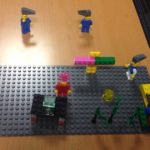Introduction to Programme Design
Or, how can Lego help you to build a course or module?
Introduction to Programme Design is a one hour staff development session for new academic staff. The session covers key information that staff need to know about how programme and module design works at the University, including signposts to the frameworks and regulations and an overview of the support available.
To help staff start thinking about the complexity of course design, we gave them some lego and asked them to work in pairs to think about the elements that need to be considered, and how they relate to each other.
Why lego?
Why not? Lego is a simple to use, non-threatening tool that helps to externalise people’s ideas in a visual way. It provides a framework for storytelling, and as you will see from the results below, can help teams to synthesise and communicate big ideas. It’s used in many companies as part of a design thinking approach, to help find creative solutions to complex problems*.
Here are some of the elements that Lego helped us to discuss. Each team was given a standard set, along with a single ‘random’ piece. Click on the thumbnail images to view the full scenes:
This team used the lego to show the lecturer and students working within and co-creating a framework, which included other elements like NILE and QAP. The bridge between the students indicates social learning. The scene also includes ‘steps to success’ and a diving board to launch them into their career. The little eyes indicate institutional oversight, and the web is used to catch the students who are not engaged and enable them to ‘bounce’ back in to the course.
This scene has a student at the centre, as the course design starts from their expectations and needs. Alongside the student is an academic and a member of support staff, indicating working in partnership. The shark is about risk: in the form of competition from other universities, and of distractions from learning – the wall is a protection against this. The raised platform indicates student support, including academic standards, facilities like NILE and IT, and skills for employability.
Stakeholders in this scene include service users and commissioners, who are central to programme design for Health courses, as these must consider the needs of the local area in terms of health provision. Other elements include the resources available (lecturers, skills), and the constraints e.g. professional body regulations and quality frameworks. The elephant is Waterside, which will have a ‘massive’ influence on how we move forward with programme design.
The students in this depiction were widely scattered around the room, indicating the ‘geographically dispersed nature of learning communities’. They are connected by mobile devices. The staff member has a movable ‘office’ (which could be at home, a hotdesk, overseas etc). There are signposts for learners throughout the course. The purpose of the course is to help students achieve educational, career and social mobility, indicated by climbing the ladder.
In this scene, the students (on the left) arrive at different levels and some progress faster than others. The programme lead is looking towards them to help them progress. Ahead is the University management and governance, leading the direction of the University. The horse is University strategy, leaping obstacles and providing support to students. On the right is a platform – both for celebration of success (award ceremony) and as a launchpad to a career.
The exercise helped participants to start thinking about the stakeholders that need to be considered in programme design, the aims of their programme or module, and the ways that students are supported. The discussions showed the complexity of the course design process, and shaped our conversations about how it should be supported.
If you were in this session and would like to expand on your model, or if you weren’t but you’d like to respond to the models (or create your own!), please leave us a comment below.
To sign up for a session, visit the Staff Development organisation on NILE (note: you will need to be logged in to NILE for this link to work).
*Although we didn’t have time to use it in this session, the Lego Serious Play website outlines a full methodology for this approach.
Recent Posts
- Learning Technology Team Newsletter – Semester 2, 2023/24
- Getting started with AI: A guide to using the Jisc Discovery Tool’s new AI question set.
- Blackboard Upgrade – April 2024
- Exploring the Role of GenAI Text to Enhance Academic Writing: A Conversation with Learning Development Tutor Anne-Marie Langford.
- Interview with the University’s Digital Skills Ambassador
- Blackboard Upgrade – March 2024
- Case study: GenAI in BA Fashion, Textiles, Footwear & Accesories 2024
- Exploring the Educational Potential of Generative Artificial Intelligence: Insights from David Meechan
- Exploring the Fusion of Fashion and Artificial Intelligence: Jane Mills’ Pioneering Journey – Vulcan Sessions Talk.
- Artificial Intelligence Meets Drama: Matt Bond’s PlayAI Project Chronicles the Journey
Tags
ABL Practitioner Stories Academic Skills Accessibility Active Blended Learning (ABL) ADE AI Artificial Intelligence Assessment Design Assessment Tools Blackboard Blackboard Learn Blackboard Upgrade Blended Learning Blogs CAIeRO Collaborate Collaboration Distance Learning Feedback FHES Flipped Learning iNorthampton iPad Kaltura Learner Experience MALT Mobile Newsletter NILE NILE Ultra Outside the box Panopto Presentations Quality Reflection SHED Submitting and Grading Electronically (SaGE) Turnitin Ultra Ultra Upgrade Update Updates Video Waterside XerteArchives
Site Admin






